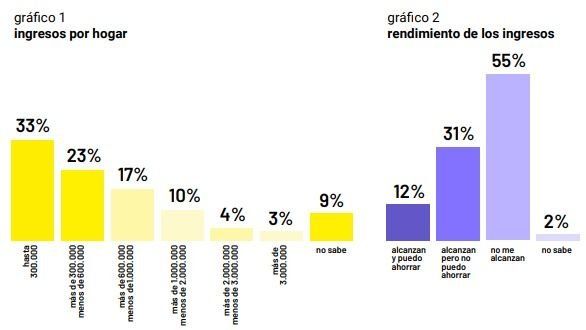According to what was revealed, The exact percentage of families that had to cut is 65%adding that 67% of households with infants claimed to have more difficulty to obtain vacancies in care spaces and gardens.
In addition, 76% of families with older adults expressed that they perceive significantly higher costsespecially in the medications who lost coverage. 74% stated an iment to hire care for these peopledue to a drop in income.
On the other hand, of the households containing people with disabilities, 64% stated that economic problems have increased to obtain providers who assure them of the necessary therapies. At par, 85% of these families identified a significant increase in medication pricesrepresenting its greatest difficulty.
According to the survey: “In the 3 groups of households, the majority of families identified having less availability of time to take care of these people in the last 6 months.
Food survey.jpg
Graphic extracted from the survey.
Report of the Intersectoral Table
The popular neighborhoods also suffered the falls, since 57% of those who attend neighborhood soup kitchens they claim having found less food. Taking into account that there are families that depend on attendance at these sites to feed themselves, the figure raises alarm bells.
“The official poverty figure for children between 0 and 14 years of age for the first half of 2024 reaches 66.1% and for the interval between 12 and 17 years old the figure rises to 69%“, expresses the Intersectoral Table in the report. Thus, the care of children is also affected, as is the case with older adults and people with disabilities. The lower the spending capacity, the greater poverty, and the greater poverty, the lower the possibilities of comply with the corresponding care.
One of the most recurrent problems that directly affects the care of these people is “the need to work long hoursto have more than one job”, to be able to support themselves and maintain or help their loved ones.
Food survey 2.jpg

Graphic extracted from the survey.
Report of the Intersectoral Table.
Gender differences
The survey also indicates that 74% of women claim that their economic situation worsened as much as that of your home. For men, 57% confirm the same concern. In both cases they had to adjust their diet and/or that of others.
At the same time, it is emphasized that “six out of 10 women overloaded their time destined to take care of their elders and the boys and girls of the house.” Meanwhile, only three out of 10 men had to do the same.
These percentages reflect that, to a greater extent, it is women who perceive the alarming increases, as well as the reduction in care spaces. In percentage terms, 43% compared to 29% of men.
Furthermore, according to the survey, the female sector resorted “less than men this last year to alternatives that redistribute the time and work of caring as therapy providers, resolution of the transfer of people with disabilities, care in nursing homes”.
Finally, the report corroborates that, both women and people belonging to sexually diverse sectors, They live day to day with a much greater level of helplessness than before. They attribute this fact to policies that dismantle care, and to the abandonment of a state present in these issues.
Source: Ambito
I am an author and journalist who has worked in the entertainment industry for over a decade. I currently work as a news editor at a major news website, and my focus is on covering the latest trends in entertainment. I also write occasional pieces for other outlets, and have authored two books about the entertainment industry.




